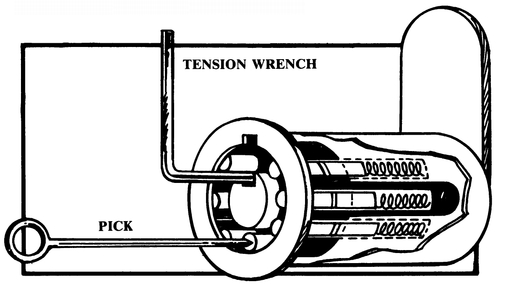Tubular Cylinder Locks
We will gradually proceed to more sophisticated locks from here. I would like to remind you that success is not based on personality. If one is arrogant about one’s lock-picking skills, one could easily be made a fool of by a lock. And no matter how many times you bash a cylinder, you will still be locked out. The only thing you accomplish is attracting an audience—so be cool.
If at this point you have had much difficulty understanding the principles of pin and wafer locks, please restudy this book from the beginning. Read it several times so as to absorb it. The information that you now have has taken me almost two decades to gather, so please be mindful of that.
Now you are about to learn how to open the more difficult locking mechanisms—some of the other 25 percent of the locks used today. You should feel confident with pin, wafer and double-wafer tumbler locks before you attempt rim cylinder locks.
Tubular cylinder locks stand out as the most generally accepted lock in all important industries using high-quality locks for protection of property, merchandise, and cash. They are recognized as giving the maximum amount of security for their price range.

Figure 25. The tubular cylinder lock locked (top), and unlocked (above).
Tubular cylinder locks are pin tumbler locks arranged on a circular plane. Unlike conventional pin tumbler locks, all of the pins are exposed to the eye. The central section of the lock rotates to operate the cam when all of the seven pins have reached their breaking points. When the proper key is entered into the lock, the tumblers are pressed into position so that the central section (plug) can be turned. This manual operation of inserting the key places the tumblers in position so that the lock can be operated and ensures that frost, dust, salt, or unfavorable climatic conditions will not affect the smooth operation of the lock.
The Chicago Ace lock is a product of the Chicago Lock Company of Chicago, Illinois. It is an effective security device and is used on vending machines, coin boxes, and burglar alarms. A larger, more complex version of it is used on bank doors and electronic teller machines. The key is of tubular shape with the cuts arranged in a circle around the key.
The pick used for this lock is the tubular cylinder pick, or you may use a straight pin or your homemade safety pin pick. The one-pronged end of the tension wrench is a little more specialized and is used for rim cylinder locks. It must be .062 inches square for best results. Any square steel stock is acceptable, as long as it fits snugly into the groove of the tubular cylinder plug.
This type of lock is a burglar’s nightmare because it takes so long to pick. You have to pick it three or four times to accomplish the unlocking radius of 120 to 180 degrees. And the cylinder locks after each time you pick it—every one-seventh of a turn.
If you leave the lock only partly picked, the key will not be able to open it, so you must pick it back into the locked position after opening it—another three or four picking sessions. In all, to unlock and lock the cylinder, you have to pick it up to eight times—quite a chore if you don’t have the right tools or time.

Figure 26. Picking a tubular cylinder lock.
These locks almost always pick in the clockwise direction. Make certain that the tension wrench fits snugly into the groove on the cylinder. Very slowly push the first pin down until it clicks, maintaining a definite clockwise pressure on the tension wrench. Once the tumbler has broken, do not push any further and proceed to the next one, and so on. As you reach the last tumbler, the tension wrench will feel more slack and give way if the lock were properly picked.
There are special keyhole saws for these locks in which you drill out the tumblers and turn the cylinder. Also, there is a special tool used by locksmiths to open rim cylinder locks.